Here’s a useful post about firewood from Mike at Damn the Matrix.
When we built our house 15 years ago, we put in a wood heater. During all that time no firewood has been bought in. 80% of the property is remnant natural eucalypt forest. No living trees have ever been cut for firewood (and never will be, at least not in the remnant section). There are dead trees that could be cut and something is always falling down, be it whole trees, large branches or kindling-sized material.
I have huge supplies of useful kindling wood from twigs up to 2-3 inches in diameter. This lot’s 40 cm long and ready to go:
These bits are a metre long and need only to be cut into three. There are 5 piles like this:
This lot’s not even cut yet. The pile is taller than I am!:
I cut this by hand with a bow saw and use my relatively new toy, a battery-operated chainsaw, for the bigger stuff. It’s easy to use and weighs in at only 4 kg, about the same as a couple of 2-litre bottles of milk (and of course, the solar panels recharge the batteries):
The really big stuff is dealt with by a neighbour in a rear property and because I can’t handle it in my size heater, he gets to keep what he cuts up.
I’m planting out a woodlot at the rear of the property, consisting mainly (at the moment) of Black Sheokes (Allocasuarina littoralis). It’s a local species, so belongs to the ecosystem, and grows quickly. The intention is to cut these for firewood in the future. It burns really well. A similar, related species, Drooping Sheoke (Allocasuarina verticillata), used to grow all along the eastern side of Port Philip Bay, south-east of Melbourne. It was cut out very early during the settlement of Melbourne, to fuel the baker’s ovens in the growing city.
Sheokes planted in a group of three, with dandelions for company:
This is permaculture zone 4—a harvestable woodlot, so the dandelions are an acceptable food species here. I’ve also planted asparagus in this area and hope that the two species will naturalise under the sheokes. I may have some problems with the rabbits—they love dandelions, but so far haven’t bothered about asparagus.
I love it that I don’t need electricity for heating. As long as trees aren’t cut at a greater rate than they grow, wood is a sustainable resource.
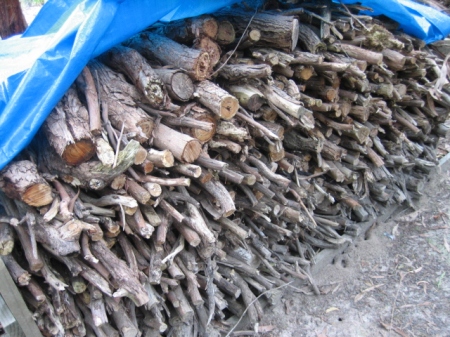
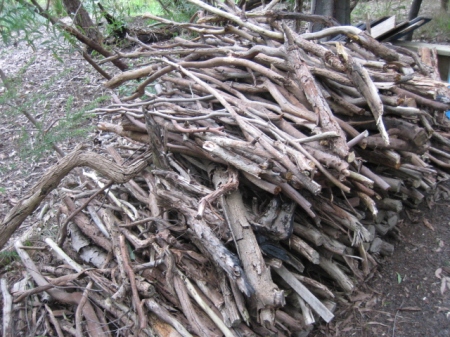
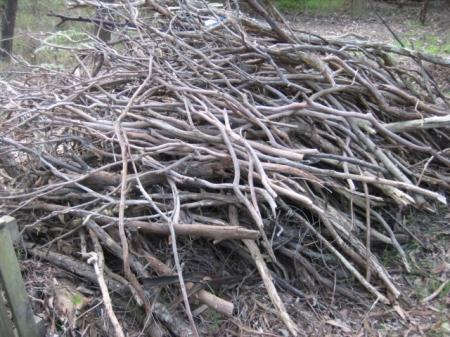
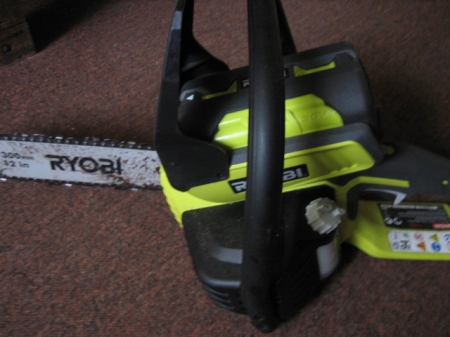
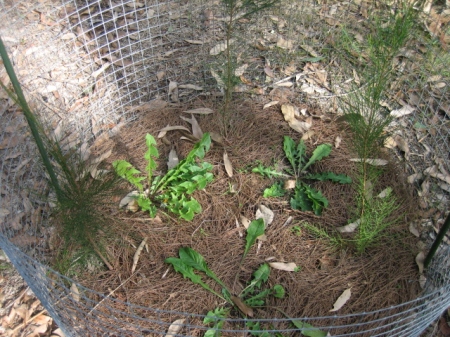
May 20, 2014 at 3:17 am |
I read this too, a good post and I love his blog.
LikeLike
May 20, 2014 at 5:18 am |
How big is your property Bev? We have predominately Allocasuarina verticillata on our property but thats more to do with the fact that it is first off the ranks when a property is cleared than anything else. My guess is that they were the first part of the seral community that occured when the original owners cleared the entire block. My dad lived here for 20 years without lifting a finger so my guess is that they grew to a small bushland area all by themselves. We are in the process of learning how to utilise our wood to the best advantage. A large rocket stove for future summer cooking is on the cards and learning to use Brunhilda to her maximum efficiency is also something that we need to do. She is most efficient (sweltering in here at the moment 😉 ) but I think we may need to learn when to keep her going and when to let her go out…a learning curve but at least we are “learning” and willing to do so, a good step on the ladder methinks.
LikeLike
May 20, 2014 at 12:35 pm |
It’s a hectare or if you’re still in acres, two and a half. All the properties in our street (about 24), are the same except the 20 acre free-range egg farm at the end. Most of the properties are mown grass and trees, but a few, like mine, have significant remnant bush on them. It’s officially a bushfire zone but we haven’t had one since 1997, when we weren’t living here then, having only just bought the property. So we’re due for another.
LikeLike
May 20, 2014 at 1:12 pm |
The thing about bushfires and Aussie native trees is that they tend to survive admirably (no so houses 😦 ). I was under the impression that we should all plant lots of eucalyptus etc. to withstand bushfires but apparently oak trees and other large deciduous trees fare better in bushfires…go figure! We are on 4 acres here and our back block is all remnant bush, mostly sheoaks. We don’t venture up there much to be honest so whatever lives up there is alright by us! (So long as it doesn’t eat chooks that is! 😉 )
LikeLike
May 20, 2014 at 6:18 pm |
Eucalypts are full of volatile oils; That’s why they burn so well. Oaks would be better. Blackwood wattles are supposed to be somewhat fire-retardant, but I have no experience of them in a fire. Thankfully!
LikeLike
May 21, 2014 at 3:13 am |
Our larger species here consist of Eucalyptus viminalis, Eucalyptus obliqua (stringy barks) that are all dying out thanks to climate change (too warm and too dry here for them now) and blackwoods. We are never short of a blackwood tree. I have them sprouting up through the side “lawn” (a word on Serendipity Farm for an area of some kind of grass where the grassy species is predominately feral and there are other things growing in it 😉 ) all over the place. Must have been a good year for them 😉
LikeLike
May 20, 2014 at 10:16 am |
The casuarinas and allocasuarinas (including verticillata), are earmarked for our place too. I needed a fast-growing, hot-burning native tolerant of wet feet to plant out across the creek. That will be our woodlot. I’m also adding blackwood and a local wattle or 2 as they will all grow well there I feel. We heat entirely with wood and in winter, cook entirely with it too. 🙂 Nothing like the ambient glow of a wood fire/heater. 🙂
LikeLike
May 20, 2014 at 12:51 pm |
Have you thought of Swamp Gum (Eucalyptus ovata)? It grows down the back of the property here, where it can get quite wet in a rainy winter. I’ve planted lots of Blackwoods too. They are a lovely erect tree and sometimes will sucker, which is useful. I’m not sure how much wet feet casuarinas will tolerate, so I’m not planting them in excessively wet areas.
LikeLike
May 20, 2014 at 3:27 pm |
I did several hours of trawling the net and found some that will tolerate heavy soils and wet feet. Swamp she oak and Verticillata will tolerate the wet. The area is wet but not waterlogged (the creek is somewhat eroded down so the trees aren’t sitting in the water) and currently it’s loaded with hawthorns, poplars and a couple of willows just upstream from our block too.
I will look up swamp gums though. Thank you
LikeLike
May 20, 2014 at 6:20 pm |
Forgot to say they have very dense wood and burn well.
LikeLike
May 21, 2014 at 10:14 am |
Some of the hottest burning in the world if what I read was to be believed. 🙂
LikeLike
May 23, 2014 at 4:11 am |
To make an easy hoop enclosure for your firewood. Hammer 3 rebar states in the ground and 8 ft away do the same. Stretch a cattle panel inside one set and do the same with the others. Cover with heavy tarp. 4′ x 8′ hoop to keep your wood dry. Also works on a lot of other things. ha
LikeLike
June 7, 2014 at 8:45 pm |
I would not have high hopes about the dandelions doing overly well where you have planted them as sheokes tend to be highly allelopathic. I use the casuarina pine needles in places where I want to prevent grass and weeds growing organically.
You may find that the dandelions do a lot better and naturalise if you give them some space.
LikeLike
June 8, 2014 at 12:27 pm |
Thanks for the tip, Larry. I did know they were allelopathic but had forgotten. The casuarinas are planted in widely-spaced groups of three, so maybe the dandelions will self-sow in the spaces in between. In any case, now I will try a carpet of needles as mulch where I don’t want weeds. That should work well.
LikeLike